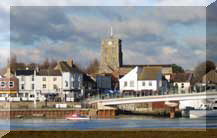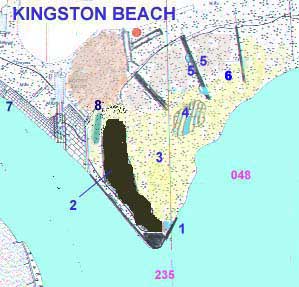 |
|
|
|
SEASHORE PAGE 2004 |
|
|
|
|
| Adur Flood Plain |
| Chalk Downs |
| Coastal Fringe |
| Intertidal (Seashore) |
| River Adur Estuary |
| River Adur Flood Plain |
| Sea (off Sussex) |
| Town & Gardens |
| Widewater Lagoon |
|
|
| 1) TQ 2351 0476 |
| 2) TQ 2345 048 |
| 3) TQ 235 048 |
| 4) TQ 2352 0485 |
| 5) TQ 2352 0490 |
 |
|
This barnacle
is found
|
|
|
AT
KINGSTON
BEACH, SHOREHAM-BY-SEA
with
Andy
Horton
|
Distance between 1 & 5 = approx. 400 metres (¼ mile) |
|
- The
purple numbers (in brackets) are the locations on the map above.

Kingston
Beach
Photograph
by Andy Horton
WILDLIFE REPORT PAGES 2005
14
October 2004
As
an ominous black cloud rolled in from the west and made the darkness set
in early, it was the pools underneath the groyne
to the east of the Launching Ramp (5)
that
produced the most life on a low spring 0.5 metre tide with a handful of
Bullheads
Taurulus
bubalis, (in small number s of a common fish this summer) a
single 5-Bearded Rockling,
Ciliata
mustela, a first year Corkwing
Wrasse,
Symphodus
melops, and two Shore Crabs,
Carcinus
meanas.
 |
 |
Further
down the shore (3)
there were two Edible Crabs,
Cancer
pagurus, and a Hairy Crab,
Pilumnus
hirtellus, and a Shore Squat Lobster,
Galathea
squamifera, under rocks. There were a few small
prawns,
Palaemon elegans, in the
pools.
A
Dogwhelk,
Nucella
lapillus, was seen on the mussel
beds (2) and
a few Oysters
were noticed (3).
A
pair of Mute Swans
flew overhead from west to east as dusk descended.
30
August 2004
On
a low spring tide, a Little Egret
was feeding on very small prawns or Common Gobies
in the shallows and an Oystercatcher
was on the mud flats.
The
rock
pools below Chart Datum had the usual moble fauna including edible
sized prawns Paleamon
serratus, first year Corkwing
Wrasse, Symphodus
melops, small Long-legged Spider
Crabs,
Macropodia
rostrata, a first year
Ballan
Wrasse, Labrus bergylta,
two Bullheads
Taurulus
bubalis,
and very little else. Two
nearly adult Rock Gobies, Gobius
paganellus, were netted underneath
the groynes at mid-tide level.
5 August
2004
There
was still too much silt from the flood tide dredging and despite forgetting
the handle to my prawn net, there were enough (40+) edible sized prawns,
Paleamon
serratus, to make a meal. Dozens
of small first year and one second year Corkwing
Wrasse, Symphodus
melops, were captured in the net, together with a first year green
Ballan
Wrasse, Labrus bergylta, a
tiny Blenny
Lipophrys
pholis, and small Bullhead
Taurulus
bubalis,
and one each of a Short-legged
Spider Crab
Eurynome
aspera, and a small Long-legged
Spider Crab,
Macropodia
rostrata,
BMLSS
Prawns and Shrimps
29
July 2004
In
the pool of water left by the receding tide underneath the middle groyne
(5)
on Kingston Beach, a Snakelocks Anemone,
Anemonia
viridis, expanded its stinging tentacles. This anemone is unusual
on this shore and reaches its easterly point of distribution on the northern
coast of the English Channel at Shoreham. The pools also contained at least
half a dozen small first year Corkwing
Wrasse, Symphodus
melops, which are a month earlier than usual between the tides.
BMLSS
Sea Anemones
 3
July 2004
3
July 2004
There
was an Australian Black Swan
in the mouth of the River Adur estuary.
6
May 2004
On
the low spring tide, there was a small first year Corkwing
Wrasse, Symphodus melops,
in the pools under the damaged groynes (5)
at mid-tide level, which was uncommon.
5 April
2004
Two
Oystercatchers,
Haematopus
ostralegus, did not even fly off straightaway
when approached and on the low spring tide they waddled from the mussel
beds (1) to the
mud flats.
 A
single Butterfish, Pholis
gunnellus, hid under a rock. A single
dirty grey Dogwhelk, Nucella
lapillus, (a predatory gastropod, snail-like, mollusc) was
in the middle of laying egg capsules
under another rock at mid-tide level
(4)
amongst the
mussel beds. This was surprising
as the first recorded observation of the egg capsules on Kingston Beach.
The Dogwhelks were not seen from 1971 to 2001 and the absence may be because
of TBT pollution, which prevented the Dogwhelks from breeding. The other
possibility is the Dogwhelks returned after spreading from the new syenite
rock sea defences on Southwick beach which
are inimical to Dogwhelks and to the mussels and Acorn
Barnacles on which they feed.
A
single Butterfish, Pholis
gunnellus, hid under a rock. A single
dirty grey Dogwhelk, Nucella
lapillus, (a predatory gastropod, snail-like, mollusc) was
in the middle of laying egg capsules
under another rock at mid-tide level
(4)
amongst the
mussel beds. This was surprising
as the first recorded observation of the egg capsules on Kingston Beach.
The Dogwhelks were not seen from 1971 to 2001 and the absence may be because
of TBT pollution, which prevented the Dogwhelks from breeding. The other
possibility is the Dogwhelks returned after spreading from the new syenite
rock sea defences on Southwick beach which
are inimical to Dogwhelks and to the mussels and Acorn
Barnacles on which they feed.
Trouble
with Dogwhelks
BMLSS
Molluscs
6 March
2004
Four
Oystercatchers,
Haematopus
ostralegus, and a Redshank
probed
amongst the mussels on a low spring tide
that nearly reached the Tide Marker (1)
at its maximum ebb.
15
February 2004
An
Oystercatcher,
Haematopus
ostralegus, and a Redshank
probed
amongst the mussels on a low neap tide
that revealed the end of the groynes at its maximum ebb. A single Mute
Swan was resting on the swell in the entrance
to Shoreham Harbour.
5 January
2004
As
the Shoreham Harbour fog horn boomed, four Oystercatchers,
Haematopus
ostralegus, probed for worms amongst
the mussel beds and sand.
21
October 2003
The
black and white wing was the first indication of an Oystercatcher,
Haematopus
ostralegus, that descended
to land on the loose rock shore of Kingston Beach on a low neap tide.
A careful watch for a few minutes through my binoculars and the Oystercatcher
was attempting the repeated stabbing with its medium-length black beak,
which is a behavioural characteristic of this bird. It was meant as one
of several techniques to stab at mussels to get
at the rich flesh inside. It was not successful and the tide would not
go out any further to reveal the mussel beds (on a 1.9 metre low neap tide)
and there would not be more than an occasional mussel exposed *, and it
may have been stabbing at the hinges of exposed cockles?
(* Mussels need be submerged for every tide.)
The
red legs of the Oystercatcher were
matched by a well camouflaged Redshank
between the launching ramp and the first groyne.
Oystercatchers
on Lundy (Behaviour)
The
Groyne to the east of the Launching Ramp (5)
Tide
level: 1.94 metres, neap low water
Over the shallow pool near the Lifeboat Station the red breast of a Kingfisher stood out from the pipeline it was perched on (8). Ironically, a couple of Crows had managed to prise out a clump of mussels.
19
October 2003
The
neap tide variation between 2.36 metres (low at 12.04
pm) and the high tide of 4.4 metres (6:14
pm in darkness) is one of the smallest possible.
(The equinoctial spring tide variation could be up to 7 metres).
BMLSS
Tides
- Sussex
Seaweed Project
Sussex Seaweed Project database
Shoreham Lifeboat Station is located at Kingston Beach
Shoreham Rowing Club meet at Kingston Beach
Wildlife News: Marine Latest
|
|
|
|
|
News 2018 |
Membership Form |
|
|
|
|
|
|

